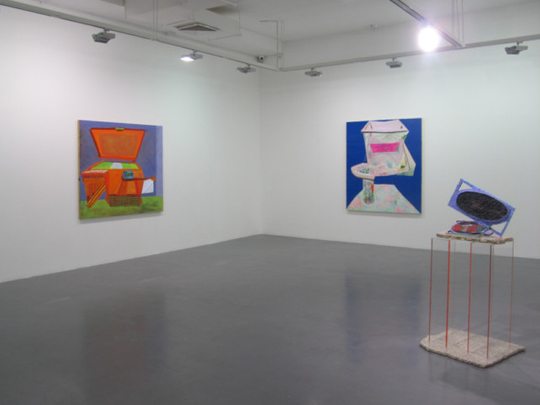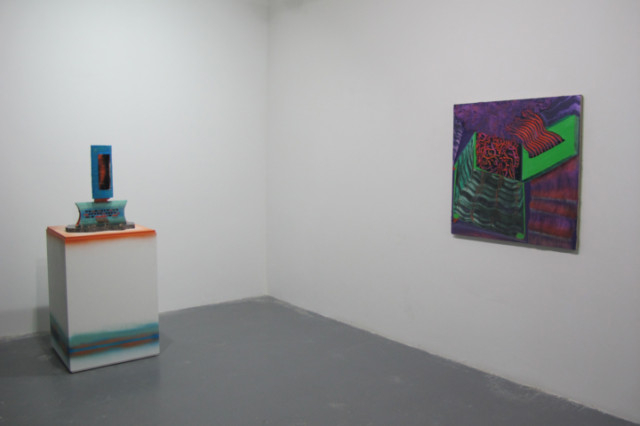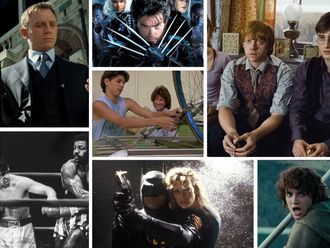
Today modern technology and machines are increasingly being used by artists to create art. But in a reversal of this trend, Andrzej Zielinski uses traditional painting to create machines. The American artist’s subjects include shredders, photocopiers, ATM machines and computers. But unlike the dull, boring, mass-produced machines we see around us, Zielinski’s machines are colourful, glowing with an inner energy, and appear almost human with distinct personalities.
Zielinski’s heavily textured paintings have a sculptural quality, inviting viewers to press the buttons on the life-size machines and to interact with them. Despite the inanimate central characters on the canvases, they look like “figurative” paintings, and are designed to make viewers stop and think about the machines and the mysterious technology behind them that have become so much a part of our life. The artist’s first show in Dubai, “You Are Disconnected, Would You Like To Proceed?” features his sculptural paintings of various machines as well as a series of equally colourful sculptures of machines. Zielinski spoke with Weekend Review about his unusual subject and style.
Excerpts:
Why did you choose this subject?
Computers and other machines are becoming more and more part of our lives, and as an artist I wanted to respond to that. I felt that the best way to tackle technology was with an older form of technology. Modern technology is essentially about communication, so I am using painting — an ancient form of communication — to talk about contemporary methods of communication. My generation is obsessed with connectivity and new gadgets. They worry about being disconnected or falling behind the times, and are constantly looking to update the gadgets, apps and programmes they use. I hope my colourful, distorted, animated machines will make viewers stop and think about how technology has led to loss of individuality and lack of direct social interaction and how machines have become an extension of our personality.
What was the reason for using this sculptural technique in your paintings?
I have used new materials such as transparent gels and modelling paste to create a parallel between the technology I am painting and the new technology of paints. I have also included references to the artist’s hand and to old times such as the paper with my name and some Roman numerals handwritten on it, being copied and enlarged in a photocopying machine. The buttons, handles and panels jutting out of the artworks refer to how we interact with these machines without really understanding what happens inside when we press a button or insert our credit card.
Did you deliberately make the machines look intimidating?
I want to show both the positive and negative sides of technology. Some of the machines look like monsters, referring to the destructive applications of technology and the fact that many people feel threatened by technology. But the festive colours I have used express the beneficial aspect of technology and my positive outlook towards it. A shredder could be seen as destroying information or protecting it. Similarly in one of my paintings, a shredder seems to be shredding paint, reflecting the fear of an old way of doing things being replaced by new technology. But it could also be seen as creating the paint. The idea of humanising machines is to shock people into slowing down and looking at something familiar with a fresh perspective.
Is there a reference to ancient icon paintings in your work?
These days we depend on these machines so much and cannot manage without them. They protect our documents, our money, help us to create and do many things for us. So they are icons of our times. You could see them as religious icons, or as the icons on our computer screens, which are the entry points into various software programs. But they are also icons that take you into a visual software program created by my imagination and that of the viewer.
How did you take your ideas forward from the paintings to the sculptures?
Once again I have used traditional materials such as bronze, natural rock and wood, along with new materials such as Plexiglas to create these three-dimensional renderings of laptops. The thing one usually looks at in a laptop is the screen. But I have tried to take the attention away from the screen and draw the eyes downwards by using bright colours and natural stones and by painting the pedestals. The granite rocks on which the sculptures are placed allude to the connection between the metals from which the computer is made and the earth from where the metals are mined. The element of mystery in the hollow spaces within the structure reflects the mysterious way these machines work; and the lines of paint running from the base to the top represent the Earth’s energy that powers the machines. Like my paintings, the sculptures are also about the relationship between humans and machines, about individuality, and about using my hands and an ancient form of technology to talk about present-day communication.
Jyoti Kalsi is an arts enthusiast based in Dubai.
“You Are Disconnected, Would You Like To Proceed?” will run at Mottahedan Projects, Al Quoz, until February 7.











